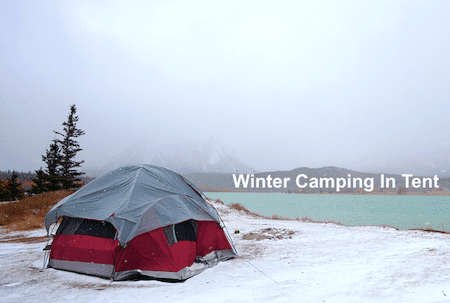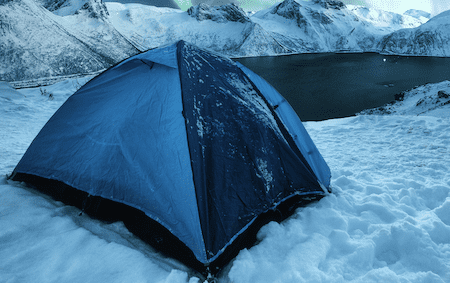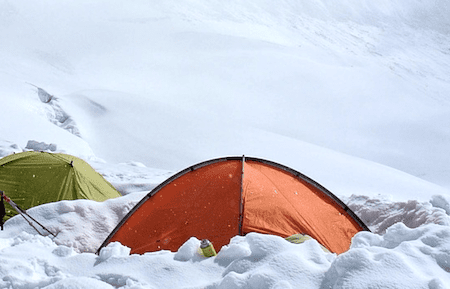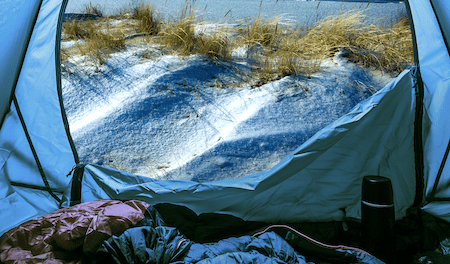The ecstasy and splendor of a pristine winter nirvana are tempting for anyone.
And what could be more satisfying than camping in your tent during winter?
There are lesser bugs and fewer people at the campsite when the sky is drizzling big crumbs of snow, and the heavy wind is blowing.
No matter how enticing it may sound, you can’t escape the challenges it brings.
Sometimes the heating gears fail to defeat the tremoring winter breeze that sends shivers down your spine.
Thus, you need to master the art of proper insulation techniques.
In today’s guide on how to insulate a tent for winter camping, you will unravel all the tips and tricks that will help you insulate your tent effectively.
It’s time to get high on the tranquil moments of winter.
10 Quick Hacks To Insulate Your Tent During Winter
Yes, in a parallel world, tents may ideally withstand all weather conditions and don’t require any insulation.
But if I am brutally honest, in the real world, no matter how much money you invest, there will be at least one occasion where your two or three-season tent falls short.
Because they don’t come with built-in insulation, and as a result, they may be giving a good fight against the high winds but barely keeping you warm inside.
Thus, you will need to add insulation to make them welcome for winter camping.
However, there are four-season tents that come with some sort of insulation as a default feature. Yet it may not be enough because winter weather has the most volatile characteristic.
You never know what’s coming. Therefore, it’s always plausible to have some additional insulation techniques in mind.
So, without any further ado, let’s get into the various insulation tips and tricks.
#1. A Multi-Functional Tent
To ensure a comfortable night’s sleep, one of the essential things you can do is bring a quality four-season tent along with you on your winter excursions.
In reality, the internal structure of the tent is one of the most significant distinctions between a four-season and three-season tent.
You’ll have a canopy on your three-season tent that’s tailored from large mesh, which is excellent for airflow in the summer but won’t keep you warm at night.
On the other hand, four-season tents feature stronger inside textiles, making them better equipped to keep you warm in the cold.
You’ll be better prepared for a good night’s sleep if you choose a tent that is versatile and can be used in any season.
Quick Tip: Before taking the decision learn the difference between 3 and 4 season tents.
#2. The Smaller, The Better
If you’re going winter camping, you’ll probably want to go for a compact tent. The narrower the space, the warmer the tent remains.
Inside a small tent, you will always lounge closer to the heat, and when you choose a narrow tent, you have very limited space to heat and insulate.
It simplifies the whole insulation process and offers you a trouble-free winter camping experience.
But when you are camping with a group of four people and want the extra storage capacity that includes accommodation for at least six-person, you’ll need to insulate and heat the additional room too.
Because after a long day of hiking and participating in numerous activities, you will crave an uninterrupted and comfortable slumber.
If that’s the case, you can opt for tents that are specifically made for such circumstances.
There are plenty of options available in the market where winter-camping tent provides built-in insulation for the additional space.
Also, these tents facilitate installing a small, portable stove inside so that you can keep yourself warm.
It’s almost like having a campfire inside the tent. Anyways before bringing any heating items or heating sources inside the tent, make sure you know enough about its using process.
Moreover, check the tent’s instruction manual to decipher whether there are any safety measures to be followed or not.
Lastly, keep the stove or heat source in hindsight.
#3. Use Tarp As A Shield Against The Wind
Strong winds are common in the winter, and they may have a significant impact on your ability to stay warm at night.
Blustery conditions in the mountains are typically more difficult to deal with than frigid air temperatures during winter camping.
One minute, you may think the weather is calm, and the temperature is under control, and the next minute, you will notice a trivial change in the temperature or the wind flow, which will alter the whole surrounding upside down.
The mild winter day will turn into a freezing night and give you chill bumps every other minute during your sleep.
Hence if you don’t want to ruin your precious sleep with the unpredictable winter wind, you must discover strategies to shield yourself.
Additionally, you may want to consider hanging a camping tarp in the direction of the wind to keep chilly air from leaking into your tent, as well as your rain fly.
As a result, you’ll be able to enjoy a good night’s sleep even if strong winds blow across your campground at night.
Or you can sit inside the tent and enjoy the rattling sound of the campfire while reading your favorite novel.
#4. Make A Barrier Out Of Snow
Winter camping comes with its blessings. And one of them is the snow itself.
With the huge supply of snow in the place you are camping, you can construct your own windbreaker. Building a snow wall will deter the snow from piling outside of the tent at night.
The quantity of snow available at your camping location will obviously affect your capacity to construct a windbreak.
Still, even with just two to three ft. of snow on the ground, you can usually build a substantial wall.
A shovel and some spare times are all that’s required for you to create a snow wall. Build a three to four ft. high snow wall around your tent with the help of a shovel.
Concentrate on the side of the tent that is exposed to the prevailing winds if you don’t have the perfect amount of snow to enclose it in the snow completely.
Now, if you have no snow at all on the campsite, you can use natural alternatives such as a fallen tree, a large mass of bushes, and a heap of rocks.
This method goes a long way regardless of the season you choose to camp.
You can also carry a heavy-duty tarp and a durable, tear-proof rope with you so you can tie the tarp amid two trees that are facing against the wind of your tent.
This is the most effective and powerful way to resist the heavy wind. Thus, investing in a heavy-duty tarp is always a sensible move.
#5. Use Thermal Or Insulating Blankets
If you are given options whether to protect the ground or the top, it’s advised to go for the latter.
Because rain droplets, snow, and mist will be falling over your tent and thus it hinders the warmness of your tent, and you will start feeling cold. Now to insulate your tent’s top, you can use a thermal blanket.
A thermal blanket is a strategically designed blanket crafted from a heat-reflective, light plastic sheet. For its lightweight feature, you can use and store it conveniently.
Despite having thin plastic sheeting, its material is capable enough to preserve the heat inside.
Hence when you wrap the top of the tent with a thermal blanket, the inner environment remains warm by dwindling the body heat loss.
As a result, you can sleep peacefully at night and stay warm all night long.
Hot air rises, while cold air falls. If you’re planning on sleeping in Glacier National Park during the winter, you may realize that the natural insulation of your multi-functional tent isn’t enough to keep you warm.
A big thermal blanket or other heat-reflective material, such as a space blanket, draped over the top of your tent will help keep you warmer at night by retaining your body heat.
#6. Use Insulating Fabric As Lining
It has happened on many occasions when putting a thermal blanket on top of the tent doesn’t suffice.
If that’s something you are facing while camping on a winter night or had faced earlier, then ensure lining the top with extra insulation fabric.
Based on the size of the tent in issue, you have a few alternatives for insulating the roof and walls.
And to harness this tip, you will need a space blanket. Once you have it in hand, tear it apart in multiple pieces and varying sizes and use them to line the interior of your tent.
If you are determined to elevate your inside warmth and comfort to the highest level, you can invest in insulated sheet fabrics.
However, due to these things’ size and weight, this sort of protection is more feasible for vehicle camping-based activities.
Also, don’t forget to cover the top and walls of the tent with padding. Make sure to conceal all the areas that can draw in cold air inside.
For instance, seal the mesh windows and screen doors.
This may not bring some drastic changes to the overall insulation, yet the concealment of the panels can reduce the intensity of cold air seeping inside the tent.
#7. Insulate The Bottom Of Your Tent Too
You don’t want to feel warm from the top while your feet are cold. Thus, only the insulation of the top isn’t enough; you need to bat an eye to the wet and frosty ground.
Insulation of the tent ground can be done with blankets, rugs, and mats. If you don’t have access to these, you can also use large towels.
This way, you can easily insulate the bottom of your tent and feel consistently warm inside.
Mostly when you are sleeping, the ground’s dampness pierces your bones with chillness, and that’s where ground insulation comes into play.
There are also options available such as using a footprint or groundsheet.
Honestly, they are extraordinarily effective when it’s about offering maximum protection because tent footprints are usually structures made of huge strips of waterproof fabric.
You can ask the tent manufacturer for some custom-cut tent footprints if possible.
However, it’s important to ensure purchasing a groundsheet or a blanket equal to the size of the tent’s floor space. To keep your stuff dry and tidy at night, it’s a good idea to have a foundation that protects the vestibule of your tent.
#8. Use Foam Padding For The Floor
Insulating your tent from the outside may be enough, but reinforcing the interior with foam padding will amplify the retention of warmth. There are foam cushioning vastly available near you at a competitive price point.
Once you have them, cover the tent floor with them, although you are already sleeping on a mattress or airbed.
By adding foam cushioning to your insulation criteria, you can minimize the heat distribution between the ground and the tent. It will work like a buffer to prevent the dampness from reaching your body.
If you are camping with sleeping pads, you are more vulnerable to the coldness that derives from the snowy, chilly, and damp ground.
So, in this aspect, make sure to use foam padding no matter what.
#9. Use Rugs Or Carpets
Sometimes the snow melts into the ground, and it becomes excessively wet and cold.
If you are camping in a place where the surface is very soggy due to moisture absorption, you can cover the bottom of your tent with some rugs or large pieces of old carpet.
It will block the dampness from penetrating the tent floor and retain the heat inside.
Well, indeed, using a rug or a carpet doesn’t go a long way due to the lack of innate insulation quality, whereas foam cushioning works wonders.
Still, adding them to your insulation gears can maximize comfort and develop overall warmth.
#10. Invest In A Portable Tent Heater
After all these efforts, if the warmth still doesn’t appease the standard of your satisfaction, then purchase a portable tent heater from a reliable shop. There are many options available in the marketplace.
You will find them in diverse sizes, shapes, heating capacities, weight, portability, and additional features. According to your preference and budget, you must choose a suitable tent heater for your winter camping.
Also, it’s essential to check whether the heater is generated by gas or electricity. If your tent has access to an electric power source, you can go for the electric-powered ones.
On the other hand, if you find gas-powered heaters more favorable for the given situation, then you can invest in them as well.
The best part is you have the freedom to choose between these two options. Please follow the tent heater safety measure to inhibit any potential danger.
Final Words
I hope from today’s guide on how to insulate a tent for winter camping; you have gathered all information that will keep you warm throughout your winter camping journey.
Apart from these tips, you can also try using sleeping bags to preserve body heat, wear thermal underwear to prevent the air from getting inside, and use heat packs on the regions of your body for added warmth.




